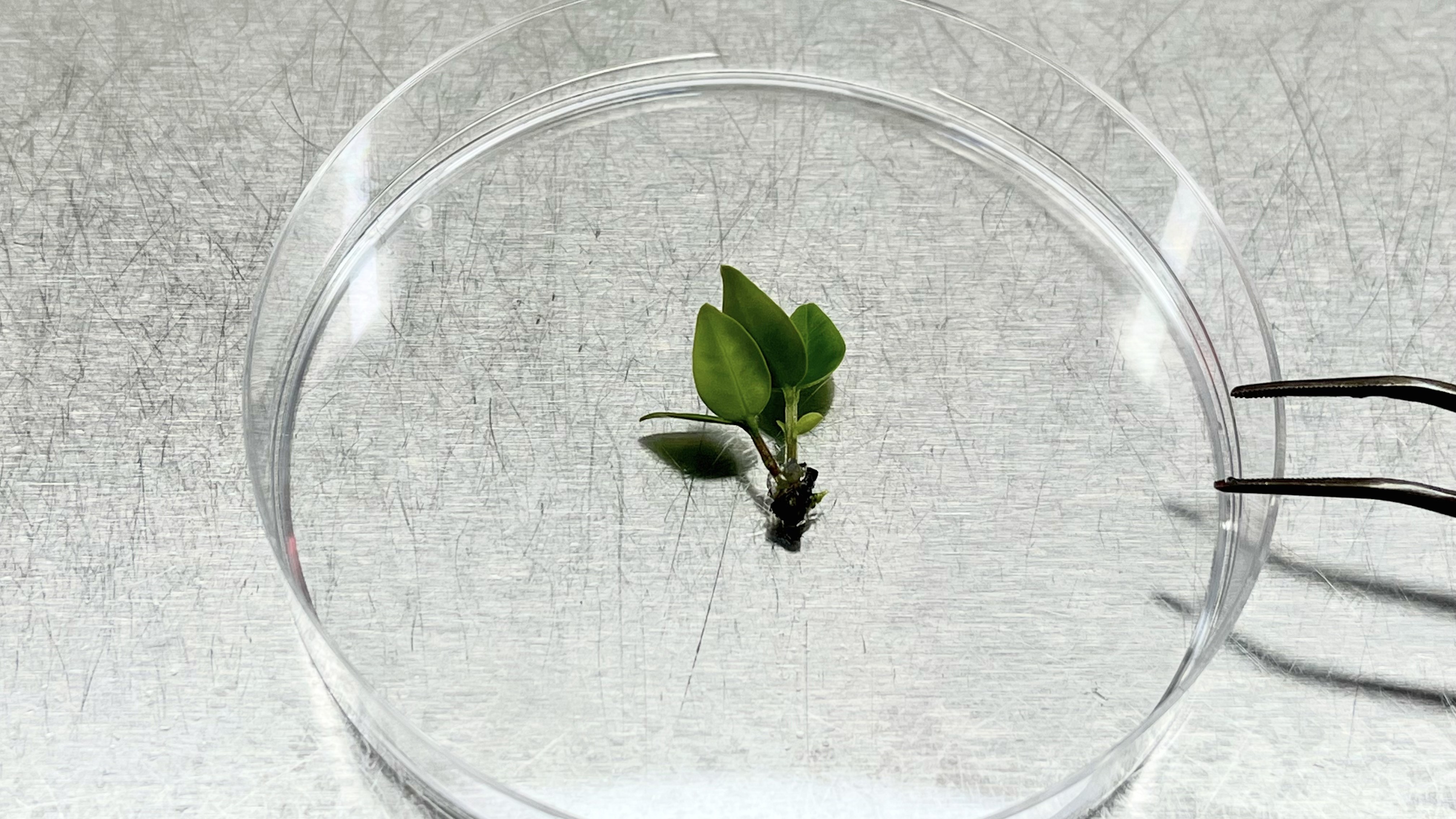‘This needs to happen fast’: Scientists race to cryopreserve a critically endangered tree before it goes extinct
By Sascha Pare
Copyright livescience

Skip to main content
Close main menu
Live Science
Sign up to our newsletter
View Profile
Search Live Science
Planet Earth
Archaeology
Physics & Math
Human Behavior
Science news
Life’s Little Mysteries
Science quizzes
Newsletters
Story archive
Pawnee Star Chart
JWST ‘starlit mountaintop’ photo
Ant clones members of another species
COVID vaccine poll
Best star projecter
Don’t miss these
Extinct species
‘We’re bringing back avian dinosaurs’: De-extinction company claims it will resurrect the giant moa in next 10 years
Planet Earth
Amazon rainforest is approaching ‘tipping points’ that could transform it into a drier savanna
Extinct species
Why giant moa — a bird that once towered over humans — are even harder to de-extinct than dire wolves
Rivers & Oceans
Even a slight slowdown of key Atlantic currents poses a ‘stunning risk’ to rainforests
Climate change
A peatland in the Amazon stopped absorbing carbon. What does it mean?
Land Mammals
Return of wolves to Yellowstone has led to a surge in aspen trees unseen for 80 years
Climate change
We’re within 3 years of reaching a critical climate threshold. Can we reverse course?
Land Mammals
Earth’s early primates evolved in the cold — not the tropics
Texas puma genes rescue Florida panthers from extinction — for now
Planet Earth
One of the world’s tallest trees — the centuries-old ‘Doerner Fir’ — is on fire in Oregon.
Extinct species
Ancient DNA from Mexico’s mammoths reveals unexpected — and unexplained — genetic mysteries
Ancient whale ‘graveyard’ discovered under melting Russian glacier
8 babies spared from potentially deadly inherited diseases through new IVF ‘mitochondrial donation’ trial
Abrupt changes taking place in Antarctica ‘will affect the world for generations to come’
Humans may have untapped ‘superpowers’ from genes related to hibernation, scientists claim
Planet Earth
‘This needs to happen fast’: Scientists race to cryopreserve a critically endangered tree before it goes extinct
Sascha Pare
16 September 2025
Less than 400 angle-stemmed myrtle specimens remain in the wild in Australia. Scientists are working on ways to preserve the species so that we can bring it back at any point if it dies out.
When you purchase through links on our site, we may earn an affiliate commission. Here’s how it works.
Scientists are cryopreserving a critically endangered tree species.
(Image credit: Jingyin Bao, with funding from Logan City Council and the Australian Research Council Linkage Program (LP210200907))
Scientists in Australia are deep-freezing the shoot tips of a critically endangered tree to preserve its DNA in case the species goes extinct.
Only 380 specimens of the angle-stemmed myrtle (Gossia gonoclada) remain in the wild, with about 300 of them concentrated in the City of Logan area in southeast Queensland. If scientists manage to cryopreserve a diverse collection of genes from the species, there is a good chance they could resurrect it if it ever dies out, researchers said.
“The most important thing is preventing its continuing decline in the wild as this is where the plant is providing ecological functions and potentially cultural significance,” Alice Hayward, a plant molecular physiologist at the University of Queensland who supervises the project, told Live Science in an email. But “by capturing and keeping alive the remaining diversity of this species in cryobanks it effectively provides a back up storage device for the species,” Hayward said.
You may like
‘We’re bringing back avian dinosaurs’: De-extinction company claims it will resurrect the giant moa in next 10 years
Amazon rainforest is approaching ‘tipping points’ that could transform it into a drier savanna
Why giant moa — a bird that once towered over humans — are even harder to de-extinct than dire wolves
The angle-stemmed myrtle is a small tree that grows along waterways in Australia’s dry rainforests. It has glossy leaves, square stems and sweet, fleshy fruit that may be a food source for bats and birds, Hayward said. “There has been limited research on its ecological interactions but it likely aids in river bank stability and biodiversity,” she said.
A combination of habitat loss, rising temperatures and a deadly fungal disease called myrtle rust has drastically reduced the number of angle-stemmed myrtle plants in Australia since 2010. Myrtle rust is caused by the exotic fungus Austropuccinia psidii, which attacks the newly grown parts of trees and shrubs in the Myrtaceae family, deforming the plants’ leaves, stunting their growth and decreasing their fertility.
To save the angle-stemmed myrtle from extinction, scientists are designing a method to freeze plant tissues that can later regenerate a full tree whenever needed. Although seeds contain reproductive material, they are not suitable for this project, both because of their reduced fertility from myrtle rust infections and because they likely won’t survive long-term cryopreservation, Hayward said.
Related: ‘It is our obligation to future generations’: Scientists want thousands of human poop samples for microbe ‘doomsday vault’
Sign up for the Live Science daily newsletter now
Get the world’s most fascinating discoveries delivered straight to your inbox.
Contact me with news and offers from other Future brandsReceive email from us on behalf of our trusted partners or sponsorsBy submitting your information you agree to the Terms & Conditions and Privacy Policy and are aged 16 or over.
So instead, Hayward and Jingyin Bao, a doctoral student at the University of Queensland, plan on preserving the angle-stemmed myrtle’s shoot tips — the uppermost and actively growing parts of the plant — at ultra-low temperatures of minus 321 degrees Fahrenheit (minus 196 degrees Celsius).
This involves growing sterile shoots in a jelly and harvesting the tips before treating them with a cryoprotective solution and freezing them in liquid nitrogen, ABC News reported. Cryoprotective solutions protect plant cells during freezing by minimizing the formation of damaging ice crystals, Hayward said. Without these solutions, water inside the cells would expand, and the cells would burst; but with the solutions, the water turns “glassy” instead, she said.
Gossia gonoclada cultures in the laboratory at the University of Queensland. (Image credit: Jingyin Bao, with funding from Logan City Council and the Australian Research Council Linkage Program (LP210200907))
The method already works for the sweet myrtle (Gossia fragrantissima), which is a small tree closely related to the angle-stemmed myrtle. After freezing sweet myrtle shoot tips, Bao achieved a 100% survival rate and managed to regrow all the plants, Hayward said. “We are transitioning this to gonoclada with some success and still working to improve the survival,” she said.
You may like
‘We’re bringing back avian dinosaurs’: De-extinction company claims it will resurrect the giant moa in next 10 years
Amazon rainforest is approaching ‘tipping points’ that could transform it into a drier savanna
Why giant moa — a bird that once towered over humans — are even harder to de-extinct than dire wolves
Once the researchers land on a method for the angle-stemmed myrtle, they still need to make sure that they have enough genetic diversity in their samples to regrow a healthy population of trees.
RELATED STORIES
—Plants have a secret, second set of roots deep underground that scientists didn’t know about
—Chinese scientists create multicolored glow-in-the-dark succulents that recharge in sunlight
—2 plants randomly mated up to 1 million years ago to give rise to one of the world’s most popular drinks
“It is important that there is sufficient genetic diversity saved to provide the best chance of species survival in the future, especially if there happens to be any natural tolerance to myrtle rust or changing climate conditions,” Hayward said. “Given the threats to this species in the wild due to habitat loss and invasive species including myrtle rust this needs to happen fast.”
So far, Hayward and Bao haven’t found any disease- or climate-resistant specimens in their sample, but City of Logan authorities and their partners are working to identify resistant individuals, Hayward said. “We want to preserve the most diverse individuals, whether tolerant or not, to provide a basis for future breeding,” she explained.
And it’s not just the angle-stemmed myrtle that needs preserving in this way, Hayward said. “We need Australia and the world to implement cryobanks to ensure we can bank the diversity of … foods and endangered plants for future generations,” she said.
conservation
Sascha Pare
Social Links Navigation
Staff writer
Sascha is a U.K.-based staff writer at Live Science. She holds a bachelor’s degree in biology from the University of Southampton in England and a master’s degree in science communication from Imperial College London. Her work has appeared in The Guardian and the health website Zoe. Besides writing, she enjoys playing tennis, bread-making and browsing second-hand shops for hidden gems.
You must confirm your public display name before commenting
Please logout and then login again, you will then be prompted to enter your display name.
‘We’re bringing back avian dinosaurs’: De-extinction company claims it will resurrect the giant moa in next 10 years
Amazon rainforest is approaching ‘tipping points’ that could transform it into a drier savanna
Why giant moa — a bird that once towered over humans — are even harder to de-extinct than dire wolves
Even a slight slowdown of key Atlantic currents poses a ‘stunning risk’ to rainforests
A peatland in the Amazon stopped absorbing carbon. What does it mean?
Return of wolves to Yellowstone has led to a surge in aspen trees unseen for 80 years
Latest in Plants
Chinese scientists create multicolored glow-in-the-dark succulents that recharge in sunlight
Plants have a secret, second set of roots deep underground that scientists didn’t know about
Kilimanjaro’s giant groundsels: The strange plants that thrive on Africa’s tallest mountain
‘This should not be published’: Scientists cast doubt on study claiming trees ‘talk’ before solar eclipses
See the reconstructed home of ‘polar dinosaurs’ that thrived in the Antarctic 120 million years ago
Scientists find the best crops to grow during the apocalypse
Latest in News
‘This needs to happen fast’: Scientists race to cryopreserve a critically endangered tree before it goes extinct
World’s oldest mummies were smoke-dried 10,000 years ago in China and Southeast Asia, researchers find
Asteroid Ryugu once had ‘flowing water’, shocking analysis hints
1,900-year-old oil lamp that provided ‘light in the journey to the afterlife’ found in Roman cemetery in the Netherlands
Scientists measure the ‘natal kick’ that sent a baby black hole careening through space for the first time
‘Russian nesting doll’ virus hides inside a deadly fungus, making it even more dangerous to people
LATEST ARTICLES
‘A genuine surprise’: Near-Earth asteroid Ryugu once had ‘flowing water’ that transformed its insides
Volcanic ‘googly eyes’ stare into space from skull-like peninsula — Earth from space
World’s oldest mummies were smoke-dried 10,000 years ago in China and Southeast Asia, researchers find
1,900-year-old oil lamp that provided ‘light in the journey to the afterlife’ found in Roman cemetery in the Netherlands
Scientists measure the ‘natal kick’ that sent a baby black hole careening through space for the first time
Live Science is part of Future US Inc, an international media group and leading digital publisher. Visit our corporate site.
Contact Future’s experts
Terms and conditions
Privacy policy
Cookies policy
Accessibility Statement
Advertise with us
Web notifications
Editorial standards
How to pitch a story to us
Future US, Inc. Full 7th Floor, 130 West 42nd Street,
Please login or signup to comment
Please wait…



